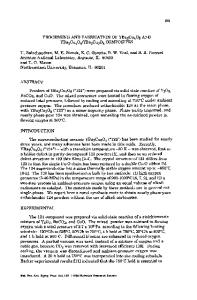Gas sensing behavior of Cu 2 O and CuO/Cu 2 O composite nanowires synthesized by template-assisted electrodeposition
- PDF / 3,220,232 Bytes
- 12 Pages / 595.276 x 790.866 pts Page_size
- 103 Downloads / 322 Views
ORIGINAL ARTICLE
Gas sensing behavior of Cu2O and CuO/Cu2O composite nanowires synthesized by template‑assisted electrodeposition Moein Hadiyan1 · Alireza Salehi1 · Hamid Mirzanejad1 Received: 1 August 2020 / Revised: 22 September 2020 / Accepted: 29 September 2020 © The Korean Ceramic Society 2020
Abstract Metal oxide-based conductometric gas sensors are one of the promising candidates for highly sensitive, harsh environment resilient, low cost and nontoxic sensors for industrial applications. Here we present conductometric gas sensors based on Cu2O and CuO/Cu2O composite nanowires investigated towards few VOCs and CO gases. The C u2O nanowires with an average length of 8 µm and diameter of 180 nm were synthesized through template-assisted electrodeposition of C u2O into a polycarbonate membrane pores, from an aqueous solution. The CuO/Cu2O composite nanowires were obtained by annealing the synthesized C u2O nanowires in an oxygen environment. The morphology, dimension, and crystallography of the synthesized nanowires are studied using scanning electron microscopy and X-ray diffraction measurements before and after annealing process. Our proposed sensor based on C u2O nanowires showed a fast response in sensing ethanol gas at 250 °C response values of 178 and 15% towards 50 and 1 ppm of ethanol, respectively. CuO/Cu2O nanowires behaved selective and sensitive at 150 °C with a response value of 55% towards 500 ppm of CO. Keywords Template-assisted · Copper oxide · Gas sensor · Nanowire · Ethanol
1 Introduction Conductometric gas sensors based on metal oxides nanostructures have been widely investigated in different industries thanks to their interesting properties such as low cost, stability in harsh environments, non-toxicity and high sensitivity. Despite decades of commercial and industrial use, researches for enhancement of gas sensing properties of metal oxide nanostructures are still a subject of interest [1–4] and has remained a challenge to address. Cu2O and CuO are two stable forms of copper oxide which both are p-type metal-oxide semiconductors. Cu2O is a semiconductor with a wide direct band gap of 1.9–2.17 eV which makes it an appealing candidate for photovoltaic [5, 6] and photocatalysts applications [7]. Cu2O based nanostructures such as nano-cubes [8], nano-octahedral [8], nano-sphere [9], and nanorod [10, 11] are widely studied
* Moein Hadiyan [email protected] 1
Semiconductor Device Laboratory, Electrical Engineering Department, K.N. Toosi University of Technology, Seyed‑Khandan Bridge, Tehran, Iran
in gas sensing for reducing gases such as ethanol, CO [10], 2S [11] and N O2 [9]. CH4 [12] and oxidizing gases such as H CuO with a narrow in-direct bandgap of 1.2 eV is mostly investigated for photodetector [13], catalytic applications [14–16] and gas sensing properties [17–20]. For gas sensing applications, CuO nanostructures sensing properties have been investigated for target gases such as CO [19, 21, 22], ethanol [23–25], formaldehyde [26], H2S [27, 28], and NO2 [
Data Loading...











